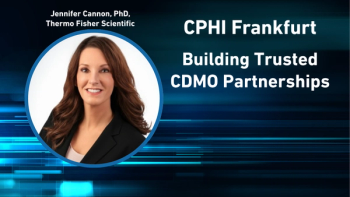
Outsourcing Perspectives from Dr. Reddy's CPS
Experts at Dr. Reddy's CPS provided commentary on the evolving role of contract services in biologics drug development and manufacturing, and solid/semi-solid development manufacturing.
Participants:
Mark Pearson, Director, Business Development
Praveen Raheja, Associate Director, Formulations
Technical/Scientific Trends
Biologics drug development and manufacturingSolid/semi-solid dosage development and manufacturing
PharmTech: What emerging technologies or practices do drug sponsors expect your organization to provide?
Mark Pearson: Drug sponsors have come to expect CMOs to offer the GMP manufacture of larger volumes of product at competitive prices. CPS has invested in a facility for the manufacture of mPEG alcohols in Mexico and a site at Mirfield, UK that can provide large-scale, multi-metric tonne GMP manufacture of activated mPEGs for biologic drugs. Increasingly, drugs being PEGylated are higher dose, which in turn requires larger scale production of PEGs for half-life extension.
Praveen Raheja: Drug sponsors expect CPS to provide enabling technologies to make their drug substance into a commercially successful drug product. Expected practices include application of advanced analytical techniques and material sciences to the manufacturing processes, as well as application of PAT (process analytical techniques) to reduce variability and improve reproducibility.
PharmTech: What scientific or technical advances have positively or negatively impacted drug development processes in this market segment?
Mark Pearson: Alternative technologies to extend the half-life of biologic drugs are being developed. This has positively impacted the drug development process by giving more choice. However, the new technologies have yet to be approved by FDA for use in commercial drugs. A sponsor would have to license a new technology. PEGs are already approved and easy to use. A lot of the emerging technologies would require specialist expertise and be more complex to set up.
Praveen Raheja: Technical advances including the decoding of the human genome, medical imaging, and new technologies that enable drug researchers to rapidly synthesize and screen numerous compounds, have led to much greater availability of information to researchers. This has in turn impacted positively on drug development by expediting the process.
PharmTech: Are you seeing shifts in demand for particular types of services? Please describe.
Praveen Raheja: More and more innovators are looking to outsource supplies, but initial drug development is something they want to keep in-house. Innovator companies are looking for outsourcing operations involving later phases of development including manufacturing GMP supplies and shipping to the clinical trial sites. CPS provides development services and GMP supplies for clinical trials.
PharmTech: What pressing technical challenges have you seen in this market segment? What actions has your company taken to resolve the challenge? What actions does your company suggest?
Mark Pearson: One challenge is the perception that PEGs can be expensive, potentially immunogenic and may accumulate in the body. Producing PEGs in larger volumes brings costs down, and there has been no evidence of adverse events in patients. Other technologies used for increasing half-life have not yet been FDA-approved. Therefore PEGs remain the preferred half-life extension technology. CPS is expanding its portfolio of activated mPEGs and activating groups to increase choice for biologics developers.
Praveen Raheja: In the last decade, we have seen a trend and demand for services to address challenges involving poorly soluble NCEs, customizing drug release for specific indications and patient populations, and handling high potent products. In manufacturing, major challenges include scaling up complex unit operations to produce reproducible products. At Dr Reddy’s, application of PAT and quality by design is a mandatory part of product development.
PharmTech: What advances do you see in science or technology in this market segment in the next five years?
Mark Pearson: There will be an increase in technologies able to prolong the half-life of biologic molecules. Companies who are looking for an appropriate half-life extension technology will screen several technologies to determine which is best. PEGs is likely to remain a significant technology but probably not the only one in regular use. There will be increasing development and use of mono-disperse PEGs and use of PEGs in new areas such as nanoparticles and niche formulations.
Praveen Raheja: Processes for drug development are becoming increasingly automated. A lot of incremental improvements have developed for process knowledge and technical capabilities. Over the next five years, application of design of experiment (DOE) will ensure that processes will be much more robust and lead to reproducible batches of complex operations.
Industry Trends
PharmTech: What regulatory changes have positively or negatively impacted drug development/manufacturing processes in this market segment?
Praveen Raheja: There is a trend to harmonize regulations, especially in developed markets (US, Europe and Japan). They have very stringent regulations in terms of controlling drug quality. Qbd is being implemented in drug product development. Although it has extended the drug development time, QbD has the advantages of ensuring processes are more robust, so should reduce costs in the long term. It’s also expected that measures such as international drug approval reciprocity will shorten the drug approval process.
PharmTech: What business trends have positively or negatively impacted drug development/ manufacturing processes in this market segment?
Praveen Raheja: A lot of consolidation is happening in the industry in the form of mergers and acquisitions. This will have beneficial effects on drug development processes that are limited by funding and resources as mergers often provide an opportunity to increase spending for selected programs.
PharmTech: What changes are you observing in the organization and operations of drug sponsors in this market segment?
Mark Pearson: Generally speaking, the outsourcing of biologics manufacturing has seen an increase over the past couple of years, where companies are outsourcing to CMOs for the manufacture of their biologic drug. This increase may be due to increased funding following the recession, and that drug companies have become more risk averse. Outsourcing mitigates risk of capital investment in manufacturing plants for the drug companies.
Praveen Raheja: Drug sponsors are now more inclined to outsource activities to CMOs with niche capabilities and CMOs that add value to the development process, either in terms of integrated operations, shorter time to market or providing support throughout the life cycle management of the product.
PharmTech: How has quality by design influenced a drug sponsor’s expectations of suppliers?
Praveen Raheja: Quality by design is a concept that has recently been made mandatory by FDA. The drug sponsor expects QbD to be built into the drug product development or drug process development. CPS has implemented the concept into the development of many of its products. The expectation is that if QbD is built into the process from the beginning it will provide a product that is more robust and reproducible.
PharmTech: Describe the role that quality agreements play in contract services relationships. How will FDA’s draft guidance on quality agreements affect the relationships between contract service providers and drug sponsors?
Mark Pearson: Quality agreements are commonplace even for a product supplier. They are used to make both parties aware of their different responsibilities. The agreement presents the responsibilities throughout the supply chain, providing a list of who is responsible for what. Most CMOs manufacture to GMP, so it is a matter of ironing out any particulars in the development of the product. The FDA’s guidance is fairly high level; most quality agreements are more detailed.
Praveen Raheja: Quality agreements define expectations in terms of meeting a quality requirement, delineating responsibilities and assuring drug quality, safety, and efficacy. The contents include purpose/scope, terms (including effective date and termination clause), dispute resolution, responsibilities including communication mechanisms and contacts, change control and revisions.
Newsletter
Get the essential updates shaping the future of pharma manufacturing and compliance—subscribe today to Pharmaceutical Technology and never miss a breakthrough.




